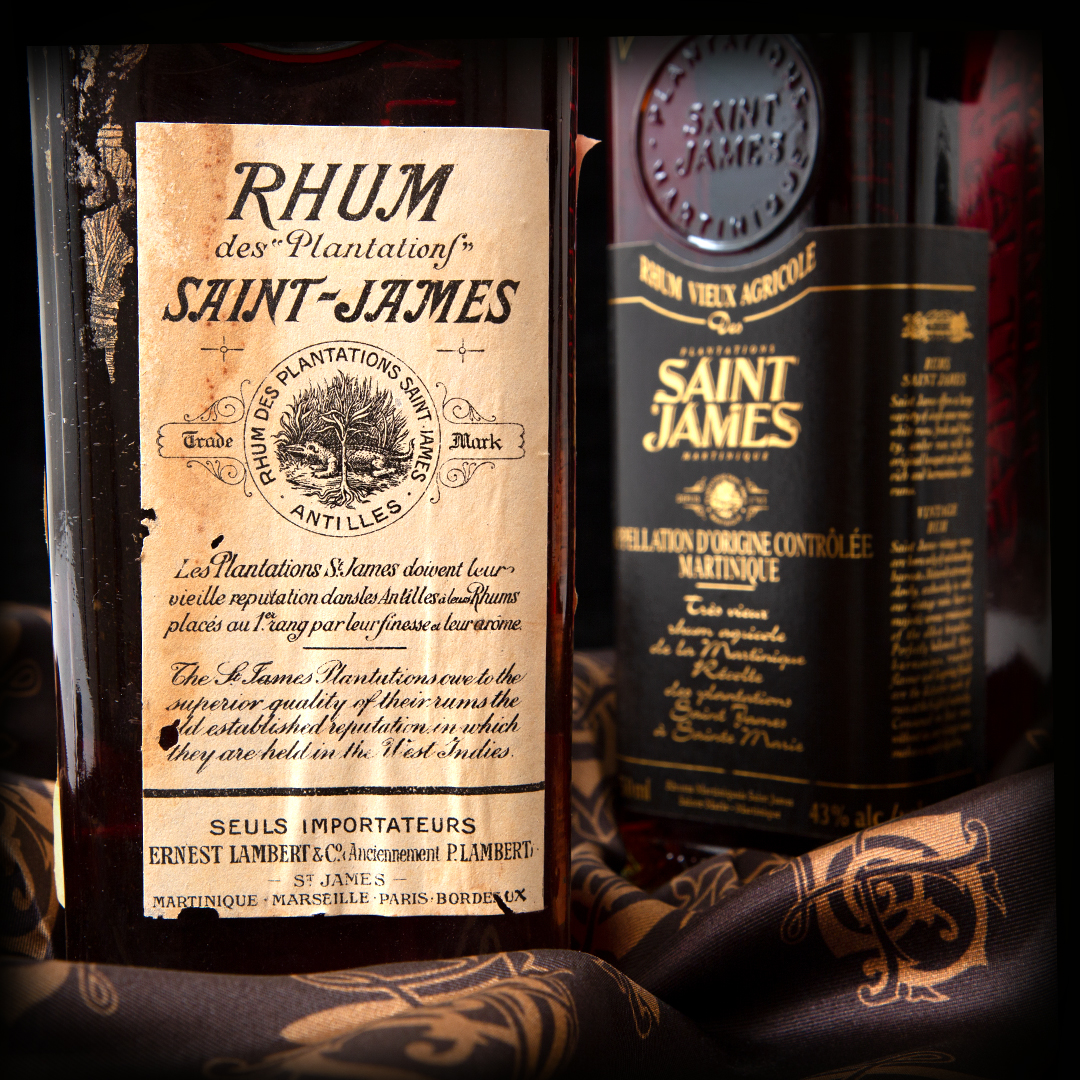The Saint-James Plantations
More than 250 years of history serving rum from Martinique.
Although the Saint-James Plantations celebrated its 250th anniversary in 2015, the beginning of this long history dates back to the end of the 17th century with the arrival in Saint-Pierre, on the orders of the "Beloved" Louis XV, of the Fathers of Charity to run the town hospital.
At the beginning of the following century, the Fathers of Charity purchased land with the aim of growing sugar cane to meet the needs of the hospital, and thus built up a large amount of property and real estate.
Subsequently, the Reverend Father Edmond Lefébure undertook the construction of a sugar factory in 1765 on the site of "Trou-Vaillant". The latter allowed the distillation of molasses residues in order to obtain a "sugar rum", also called "Tafia". Trou-Vaillant was to become the historic heart of the Saint-James Plantations.
Father Lefébure, who had realised the potential of this cane brandy, decided to continue his work by bringing in stills from France to improve the quality of these brandies. Martinique's agricultural rum was then being born...
A year later, Father Gratien Bourjot arrived from France to succeed Father Lefébure, who had passed on his experience and knowledge in the production of sugar and rum. He was then entrusted with the rum trade. Since rum shipments to France were prohibited at the time, as not to compete with wine brandies, he decided to turn to the English colonies in North America.
From then on, a commercial problem arose. Indeed, the name "Trou-Vaillant" was impossible to pronounce in English. So the clergyman decided to use the name of a habitation not far from Trou-Vaillant, called "Saint Jacques". By translating "Jacques" into English, he obtained "James". Finally, as a good man of the cloth, Father Gratien Bourjot decided to use the name of a saint to baptise his rum. Saint-James rum was born!
After a few years of exploitation, the Trou-Vaillant site and the hospital were declared national property and owned by the State in 1791. This was the case until 1861, when the habitation Trou-Vaillant was sold at auction and thus returned to the private domain.
This restoration allowed a certain Paulin Lambert, one of the biggest rum merchants in Marseille, to become interested in the production of rum in Martinique and more particularly in Saint-James rums, whose name he officially registered in 1882 at the Marseille Commercial Court. From then on, he invested himself personally in production, demanding to control the entire production process, from the cultivation of sugar cane to bottling.
At the same time, he developed the famous square bottle with a flat bottom, which he also registered the same year.
This bottle, which became the emblem of Saint-James, was revolutionary at the time. In fact, in addition to optimising space in the holds of boats, it limited breakage during major storms at sea. With it, the identity of the Saint-James brand was established.
Three years later, in 1885, Paulin Lambert decided to go further in his approach by offering his clientele of connoisseurs a vintage rum. 1885 was the first commercial vintage of Saint-James. A few rare bottles are still kept in the vintage cellar of the habitation Saint-James. This vintage will be the first of a long line of vintage rums, so coveted today.
In keeping with this quality approach, Paulin Lambert decided to use vesou (fresh cane juice) rather than molasses to make rums. An originality for the time that will allow to establish the reputation of Saint-James Rums. From then on, the merchant marketed his rums with a strong message: "Saint-James, the first agricultural rum in the French West Indies", before officially buying the habitation Trou-Vaillant in 1890. From then on, Saint-James rum set out to conquer Europe through exports. From 1895 onwards, it was so successful that commercial branches were opened in the largest European cities.
Unfortunately, this success was almost interrupted on 8 May 1902, at 8.02 a.m., when Mount Pelée erupted, reducing the town of Saint-Pierre to ashes. Miraculously, the habitation Trou-Vaillant was only partially destroyed and will be restored fairly quickly, thus continuing to satisfy the ever-increasing demand. Three other production sites were opened in Saint-Joseph, Lamentin and Case-Pilote between 1911 and 1929.
Since that time, the success of Saint-James rums has been continuously expanding. Since 1955, the company has changed owners several times, including the Picon spirits company and the Rémy Cointreau group, before becoming the property of the La Martiniquaise group in 2003, making it Europe's leading producer and distributor of agricultural rum (A.O.C).
In the meantime, Martinique's agricultural rum obtained an "A.O.C Martinique" (Appellation d'Origine Contrôlée) in 1996. This appellation expresses the intimate link established between production, the land and the know-how of the people, perpetuated over the generations from which Martinique's agricultural rums benefit.
During these various changes, production was transferred to a new distillery in Sainte-Marie, where it remains today.
As every year since 1765, the Saint-James distillery lives to the rhythm of the harvests which take place from January to June. The calendar of cane harvesting and rum distillation, known as "la campagne", starts at the end of January and the beginning of February, depending on the weather, and ends at the end of June or the beginning of July.
As with all products from the land, there are good and less good years, harvests of exceptional quality and others less so. These imponderables can have an impact on the quantity. As far as quality is concerned, even if it is also affected, the know-how and mastery acquired by Saint-James over the course of its history enable it to be maintained constant. However, at Saint-James, only the great years of harvest give rise to vintage rums.
For centuries, cutting the cane was exclusively manual and physically demanding work. Today, mechanisation allows 90% of the fields supplying the Saint-James distillery to be processed. The machines can process an average of 120 tons of cane per day and up to 400 tons when the weather conditions are optimal.
The average yield, which serves as a benchmark, is in the order of 100 to 105 litres of rum for 1 tonne of cane. Today, the total average annual production of Saint-James Plantations approaches 4 million litres of rum.
Today, Saint-James has a storage capacity of nearly 8 million litres, divided between stainless steel tanks, tuns and, above all, casks. One of the historical traditions of Saint-James is the elaboration of vintages, even if some war years did not have any due to restrictions.
In the case of a vintage rum, the cask ageing is done in order to bring out the climatic impact of the year of harvesting and to give the rum its singularity, the expression of which is accentuated by a minimum of more than 6 years of ageing.
From the beginning of its history, the great strength of Saint-James is, in addition to its know-how, its commitment to quality. Paulin Lambert was a forerunner in this field, making his rum known and recognised.
We are pleased to be able to offer you some of the rarest historical rums from the Saint-James Plantations. Indeed, whether it is the 1979 vintage or the 1939 vintage, the last pre-war Saint-James rum, or the 1982 and Saint-James 1986, two vintages produced in the midst of the rum crisis, all have become among the most difficult to find.
Whatever the reason for their rarity, tasting them will give you remarkable pleasure. Perfectly balanced and harmonious, their incredible roundness in the mouth and their length are signs of accomplished aging. Each sip will pay homage to the history of the brand, a recognition of an established know-how passed down from generation to generation to preserve its authenticity.
RHUM SAINT-JAMES - 1986 - Bottle of 70 cl
RHUM SAINT-JAMES - 1982 - Bottle of 70 cl
RHUM SAINT-JAMES - 1979 - Bottle of 70 cl
RHUM SAINT-JAMES - 1939 - Bottle of 1 L
SAINT-JAMES RUM - different cuvées and vintages available.
Login to your online account to reserve your item
or contact us at +41 22 552 2799


